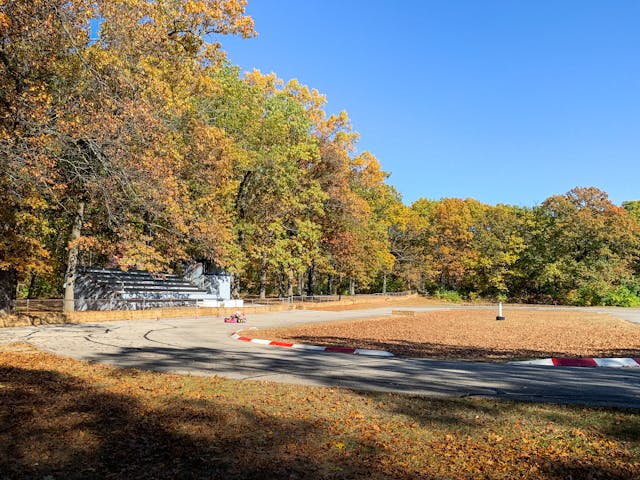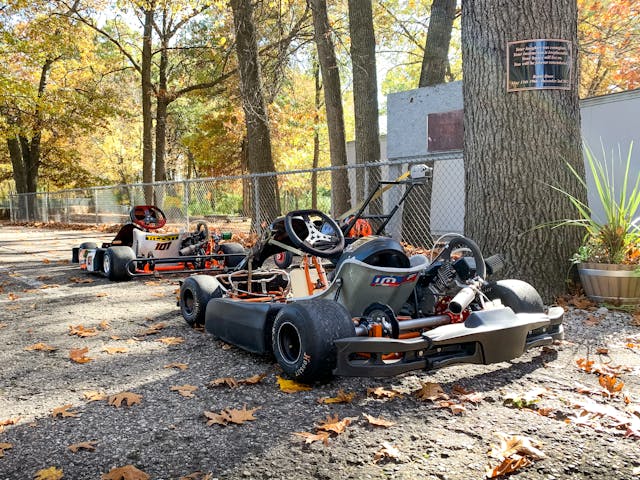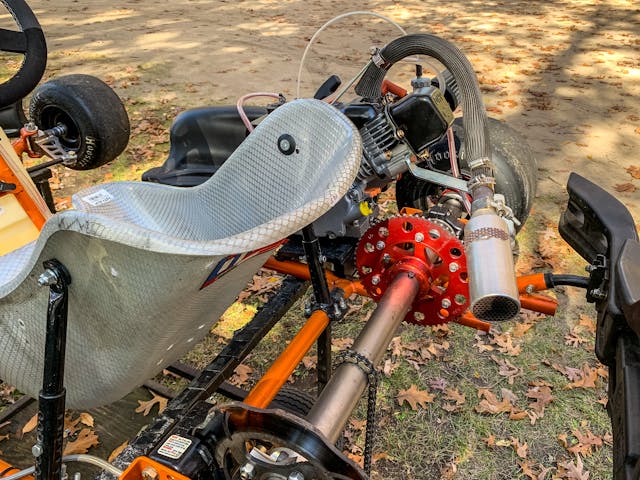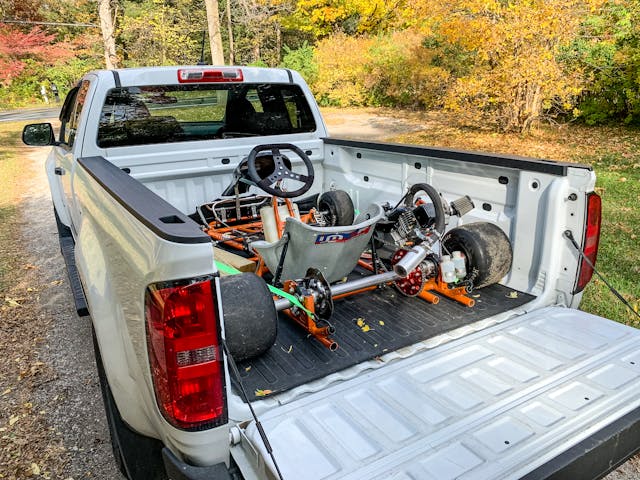6 life lessons from the local kart track
Last weekend, I visited East Lansing Kart Track (ELKT), just outside the sprawling and bucolic Michigan State University campus, for a test-and-tune. Built in 1961, the track hosts weekly racing (and open practices) April through October, for locals and far-flung speed freaks alike. The 0.45-mile course, which more closely resembles the picturesque setting of a hardwood state park, features about 10 (depending on the configuration) drastically different corners. The variety ranges from wide-open kinks to tight hairpins.
Classes are equally diverse. ELKT welcomes a half-dozen different two-stroke and four four-stroke run classes (as well as an open invitation to those who favor two wheels). My kart, a used Briggs-and-Stratton-powered Margay, slots into the L206 Senior class, which features drivers over 15-year-old and combined weight of 365 pounds or more. According to track owner Kevin Haun, this class is one of the course’s most competitive.

Haun’s family purchased the ELKT in 1973. Through his family’s stewardship, the track has not just endured since then—it’s thrived. “We were here last weekend for their season finale,” said a fellow karter, “and the pits were so packed we had to park out by the road.”
Compared to the prior weekend, Saturday’s open practice, had a totally different feel. Some karters were shaking down new pieces. There was a family of three generations setting quick times. And others, like me, were just there to turn laps and enjoy the autumn sun. Think open-top color tour in a 10-horsepower kart. The relaxed nature of the event allowed me to run the kart, digest, tune; then rinse and repeat for five hours. Unplugging, really zeroing in on an activity that demands attention and focus, has a way of letting deeper thoughts simmer in the background. I came away from my day at ELKT, particularly after interacting with the owners and drivers, feeling like I’d touched on some valuable best practices for life. Here they are, in no particular order:
Ask questions
When it comes to setting up a kart, I have no idea what I’m doing. That’s the honest truth. Prior to my visit, I orbited competency through brief calls with my father and ample time scouring karting forums. Still, there was much room for improvement. One of the easiest trackside alterations is tire pressure, and for that I turned to the experts who might know how to adjust for colder fall temps and 25-year-old surface. I asked multiple drivers for tips, ultimately arriving at an average figure for my R80 Hoosiers (which are like hockey pucks). I hit the track with 14 psi at all four corner … and quickly learned my second lesson.

Be patient
The first session of the day served as a quick reminder that some sayings really are truisms. Patience is indeed a virtue. For my early runs, my tires were cold and every corner felt as slick as ice. I imagine I looked something like a horse on rollerskates through those first few laps. Still, with other karts on track, I felt the urge to pick up pace before my tires were ready. Sort of like opening the microwave door before your leftover lasagna has fully thawed.
Hunger has a way of overriding good sense. After stabbing the throttle, it was cold lasagna for me and my kart: a lazy spin on the exit of the track’s tightest turn. I should have waited.
Make friends
This one is quite easy in a setting where people have similar proclivities. (Lesson 1—ask questions—often opens the door here.)
As I was unloading my gear, a gentleman pulled up in a Chevrolet Traverse with a single-axle open trailer. As a fellow solo operator, I took note of his kart stand, which had a hand-powered winch affixed to the end. It’s one way for lone wolves to lower our karts onto the grid.
We started talking about the stand, which led to introducing ourselves. His name is Roger. Despite being in his sixties, Roger has only been karting for four years. “I always passed this property,” he said. “Then one day, I decided to stop in.” Simple as that. Not long after, he purchased a kart and went racing.

Roger and I hit the track at the same time on multiple occasions that day. His souped-up 206 four-stroke with a billet connecting rod—and who knows what else—made him lethal on the straights. And the chrome wheels made the kart look as fast, too. I had major kart envy.
When I surrendered my kart to Associate Managing Editor Grace Houghton for her first karting adventure, Roger chirped up. “You want to try mine?” I jumped at the opportunity. In addition to forging a new friendship, the seat time allowed me to benchmark where my kart was in terms of performance. All from the seed of a little friendly banter.
Push yourself
After a couple sessions, I was really getting the hang of the nuanced track. The back section of the track has a 90-degree left-hander that can be hit wide open providing you’ve mastered the line. As I got quicker through this section, I started to hit the engine’s rev limiter earlier and earlier. To gear my kart for a higher top speed, I purchased a 63-tooth gear from Haun at the parts shop (on credit—boy, do I love the racing community). The change would sacrifice some low-end speed, and with only a couple sessions left in the day, I debated whether I should make the change at all. Call it laziness or complacency, I went back out to focus on the slower segments with the old 65-tooth sprocket.

Two laps in, I brushed ELKT’s notoriously tall curbs and slipped the chain. Fate was shouting at me to make the change. With half the job already done, I wheeled my kart back to the paddock to change sprockets. After the swap, the difference in top speed was marked. Eventually I was able to build toward a quicker lap time and eventually hit the rev limiter again, though much later on the straight. Lesson learned: Don’t rest on your laurels. Make the change.
Observe your surroundings
The final two corners—a sweeping 180-degree right followed by a 180-degree right—were especially tricky. To find my way through the set, I employed two strategies. First, I waited to go out during one of my sessions. Instead of joining the group, I posted up from a good vantage point of the problematic section and watched how the more experienced drivers were tackling the corners.

Then I hopped in and joined the fray. Positioning myself behind the veteran drivers, I embarked on an informal lead-follow. The few laps that I was able to keep the faster racers in view paid great dividends in overall speed through the tricky segment.
Get out there
I know this one sounds cheesy (and I’m half-sure it was a cruise line slogan), but stick with me. It is not easy to pack up a vehicle—whether it be a kart or a full-size race car—along with the requisite equipment, travel many miles, only to then show up to an unfamiliar place. That’d be daunting for just about anyone. The time investment alone is considerable; I can think of so many things I would rather do on the Friday night before race day than make sure my air tank is full, my tie down straps are tight, and that I have the appropriate amount of underwear. The key here: envision the sweet time that you’re going to have out on the track. These memories are going to stay with you much better than a Friday night rewatching Days of Thunder.
Regardless of the specific discipline, racing requires premeditation and focused intent. There’s no app for race prep, so just trust the process. Stick with it and get out there. It’s worth it.




We did Soap Box Derby and I agree with most of this. Yes we had no engine but racing is racing and many of the same things apply.
#1 Asking questions is key. But remember many will help you but they will never show you everything they know. Also be aware they are also searching for answers too so they may not always know.
#2 Our patients was with the track as the sun came the cars would get faster on the hot lanes vs the shaded. Also read the track to see what it is. We looked for bumps and cracks that could upset the car.
#3 We made friends that taught us much. Again remember they will never teach you everything and keep in mind they are like you too and searching for answers on set up.
#4 Learn the physics of the car set up and how each adjustment and placement affects the car. Log and document runs and times. I learned much about getting a car down a hill with only adjustable weight. I also learned how others would use the physics to try to cheat you too. One mistake I made was to set my toe from the rear on the car. Only to find the axles were tapered a bit and left me tow out. Simple things like this can mess you up.
#5 Prep the car before you leave home. It is best to work on the car at home and just leave adjustments or repairs at the track so you can focus on the driving and track.
#6 make sure to just have fun. You are going to lose more than win but enjoy the time there and any gain is a win. In time you will become competitive.
I saw too many struggle and quit in the first year. Unless you are in a family that shares all the secrets you will have a learning curve.
We also raced stock cars and it was the same thing. We were low buck but we were smart and learned and we won a fair share of races even at a disadvantage to the other higher dollar team. Prep and being smart are key. Learning how to adjust is important.
“#5 Prep the car before you leave home.”
This is one that I learned the hard way. After tackling several “honey-dos” one fine autumn day, I was hurrying to get the kart loaded up and get a few laps in before the sun got too low. I neglected to go over every nut and bolt connection, and just chucked the thing out and started it up. On the 2nd lap, the right-side tie-rod came loose on a fast left-hander, tossing me hard onto the pavement (and damaging several areas of the kart). I had a dinner plate sized hematoma on my right hip for a couple of weeks, and couldn’t get back in the seat before winter set in. After that, I checked EVERYTHING that I could think of BEFORE loading the kart, no matter how big a hurry I thought I was in.
Karting is fun. I have always enjoyed my few stints in the kart.
Comments seem to be not posting on a few articles today
I have enjoyed Karting every time I have had a chance to do it.
…. and I learned in an early driver’s school… LOOK WHERE YOU WANT TO GO! It’s a basic, and is taught in every motorcycle safety training regimen, and usually at least “mentioned” in driver’s schools (It’s assumed you know it already).. but yeah, “Push in practice; WIN in the race”
Great review Cam, I’ve looked at trying out this track before. I’d have to commit picking up a kart though!
Same principles apply for entry-level racing in other disciplines. One other rookie recommendation I’d have is to take care of your equipment. Nothing will take the wind out of your sails faster than pushing too hard too soon and breaking your car/kart or making enemies on-track on day 1.
Great write up. Keven and his wife make the ELKT feel like home. They welcome everyone and go out of their way to do so. If a parent wants to do something special with their kid, get an entry level kart/engine and spend a day with them at the track. Best memories that will outlive the parents. I say: “I’d rather race with my kid on a Friday night than race after them”. I know where he’s at and he’s having the time of his life.
Nice little write up! I raced karts as a teen in the 80s and 90s. After racing drag cars at a rather high level for 30 years, I got back into karting last year. Smiles per gallon is WAY higher. Kevin and Sandy Haun do a remarkable job of running that track. I felt like family right away. It is hard to imagine getting into a sport, motorsport or otherwise, where you will meet nicer people. I recommend ELKT and karting in general!
My Father was an Okie & my Mother is a hillbilly, but I am all Southern Californian & that fundamental difference in upbringing put a gap the size of the grand canyon between my father & myself. Despite that, Dad & I found our connection thru kart racing, a bit of common ground you might say. Dad brought home a used Rupp kart for me in August of 69, I was 8yrs old. For the better part of the next 20yrs we raced all over the West coast, occasionally further East, as far as Quincy Missouri anyway. For any father who can afford it, it’s a great way to get your child involved in an environment where substance abuse is heavily frowned upon ( these day’s anyway, not so much back in my day ) gang’s are non-existent & the life lesson’s learned translate very nicely into real life. Karting has grown tremendously since I ( due to that substance abuse thing I referred to earlier ) hung up my helmet, plug & play racing happens everyday now! Kid’s today, as well as Father’s-Mother’s can learn much from the internet before they ever lay foot in the pits, or turn a tire on a kart track. Kart racing wasn’t cheap back in our day & it’s certainly not now, but for the common ground it gave my late Father & I, it was a Hellava bargain! I’m damn proud of the race’s we won & the Duffy I won in 85 ( Trophy awarded the National’s winner’s every year in the IKF ) along with Pop’s Master Mechanic belt buckle ( awarded to the mechanic of the National’s winner ) is proudly on display in my living room as I write this, but the friendship’s earned in racing are unlike that gained in any other sport & the bond forged between Dad & i, well that is simply priceless. I lost Pop in 2019, at the age of 84 & while he’s gone from me now, I’ll alway’s have the wonderful memories of our kart racing day’s & that’s all thank’s to that Okie & the go-kart he bought for his So-Calif kid. RIP Dad, I’ll be along soon enough & I’ll just bet you already have an Open Unlimited kart ready to race on what I’m sure is the greatest track ever designed! 🙏